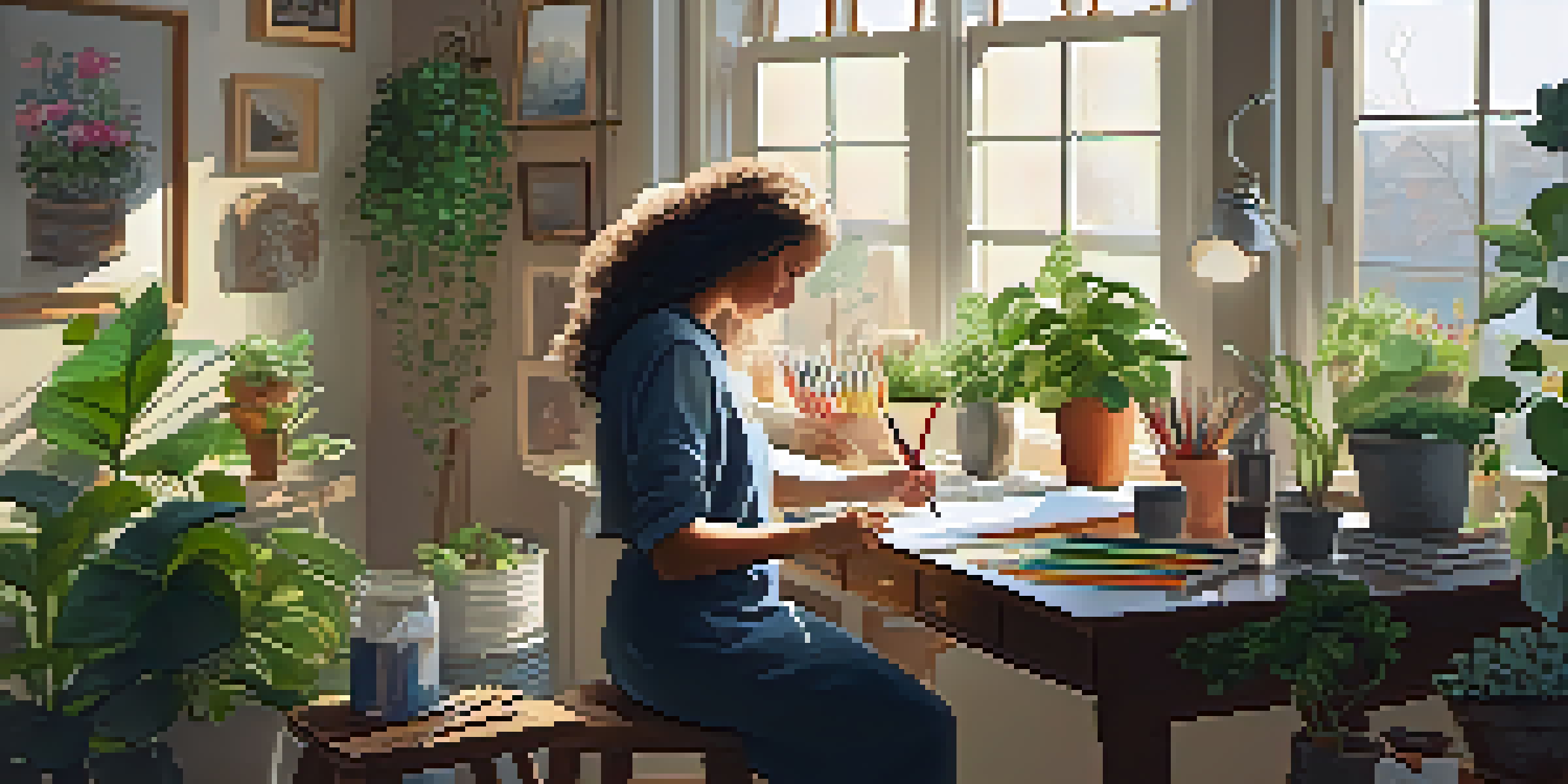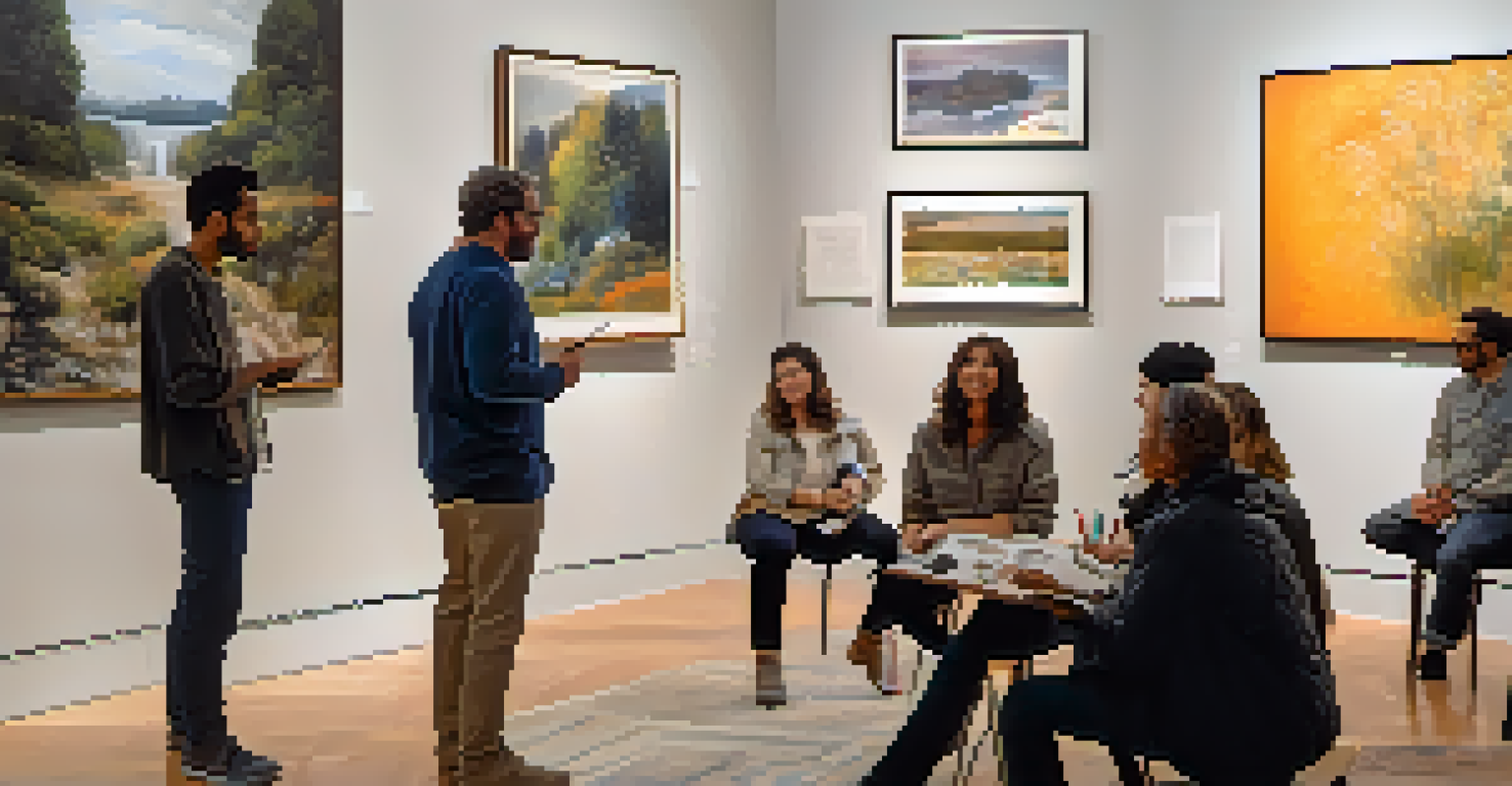The Role of Critique in Developing Your Artistic Skills

Understanding Critique and Its Importance in Art
Critique is more than just feedback; it's a vital tool for artists. It helps you see your work through different lenses, revealing aspects you might have overlooked. When you receive constructive criticism, you get insights that can guide your artistic growth and inspire new ideas.
Critique is the catalyst for growth; it challenges us to see beyond our own vision.
Think of critique as a mirror reflecting not only your strengths but also areas for improvement. This process fosters self-awareness, an essential quality for any artist striving to evolve. By understanding how others perceive your work, you can refine your skills and expand your creative boundaries.
Ultimately, critique encourages you to step outside your comfort zone. It challenges you to embrace vulnerability, allowing you to take risks and explore new techniques that enrich your artistic journey.
Different Types of Critique: Finding What Works for You
Critique can come in many forms, from formal reviews to casual conversations with peers. Each type has its unique benefits and can cater to different needs. Whether it’s a structured critique session or informal feedback, finding the right approach is essential for your growth.

For instance, a formal critique often involves a detailed analysis of your work, offering specific suggestions for improvement. On the other hand, peer feedback can provide a more personal touch, helping you feel more at ease while still receiving valuable insights. Choosing the right method can enhance your learning experience.
Critique Fuels Artistic Growth
Receiving constructive feedback helps artists identify strengths and areas for improvement, fostering self-awareness and creative evolution.
It's also crucial to seek critiques from diverse sources. Engaging with various perspectives not only enriches your understanding but also helps you develop a more rounded artistic voice. Remember, the goal is to learn and grow, so keep an open mind!
Receiving Critique: Building a Positive Mindset
Receiving critique can be challenging, especially when it feels personal. However, developing a positive mindset toward feedback is essential for growth. Instead of viewing critique as a judgment, try to see it as an opportunity to learn and improve your craft.
We do not learn from experience... we learn from reflecting on experience.
One effective strategy is to focus on the specific suggestions provided rather than getting caught up in emotions. Take notes, ask questions, and seek clarification when needed. This approach not only helps you understand the feedback better, but it also demonstrates your commitment to growth.
Additionally, remember that not all feedback will resonate with you, and that's okay. It's important to filter critiques and take what aligns with your vision and goals. Embrace the constructive parts while discarding what doesn't serve you; this balance is key to developing your artistic skills.
The Role of Self-Critique in Artistic Development
While external critique is valuable, self-critique is an equally important aspect of artistic development. This involves reflecting on your work and identifying areas where you can improve. By cultivating this habit, you become more attuned to your artistic voice and style.
Start by evaluating your work after a project is completed. Ask yourself questions like, 'What worked well?' and 'What could I have done differently?' This self-reflection not only helps you grow but also instills a sense of accountability for your progress.
Self-Critique Enhances Skills
Regular self-reflection on one's work builds accountability and confidence, making it easier to accept and learn from external critiques.
Incorporating self-critique into your routine can lead to greater confidence in your abilities. As you become more comfortable evaluating your work, you'll find it easier to accept and learn from external critiques as well.
Creating a Supportive Environment for Critique
A supportive environment is crucial when it comes to giving and receiving critique. Surrounding yourself with like-minded individuals who are also passionate about their craft can create a safe space for honest feedback. This sense of community can make all the difference in your artistic journey.
Consider joining art groups or online forums where constructive critique is encouraged. In these spaces, members can share their work and provide feedback in a respectful manner. This not only fosters camaraderie but also helps you build connections with fellow artists.
Additionally, it’s important to establish ground rules for critique sessions. Agreeing on guidelines, such as focusing on constructive comments and maintaining respect, can enhance the overall experience. A positive atmosphere allows everyone to thrive and grow together.
Turning Critique Into Action: Implementing Feedback
Receiving critique is just the first step; the real challenge lies in implementing that feedback. After gathering insights, take time to reflect and determine which suggestions resonate with you. It’s essential to integrate this feedback into your practice to see tangible improvements.
One effective method is to create a plan of action based on the critiques you receive. Identify specific areas to work on and set achievable goals. This structured approach not only keeps you focused but also motivates you to make meaningful changes in your art.
Community Supports Constructive Feedback
Creating a supportive environment with like-minded individuals encourages honest critique and helps artists thrive in their creative journeys.
Remember, improvement takes time, so be patient with yourself. As you gradually incorporate feedback into your work, you'll likely notice growth in your skills and confidence. Each step forward is a valuable part of your artistic journey.
The Long-Term Benefits of Embracing Critique
Embracing critique can significantly impact your long-term artistic development. Over time, it fosters resilience and adaptability, qualities that are essential for any artist. As you learn to navigate feedback, you become more equipped to face the challenges inherent in the creative process.
Moreover, embracing critique helps you develop a deeper understanding of your work and the art world. With each piece of feedback, you gain insights that contribute to your overall growth as an artist. This ongoing journey is what fuels creativity and innovation in your practice.

Ultimately, the ability to accept and learn from critique can lead to greater artistic fulfillment. By viewing feedback as a stepping stone rather than a stumbling block, you empower yourself to reach new heights in your creative endeavors.